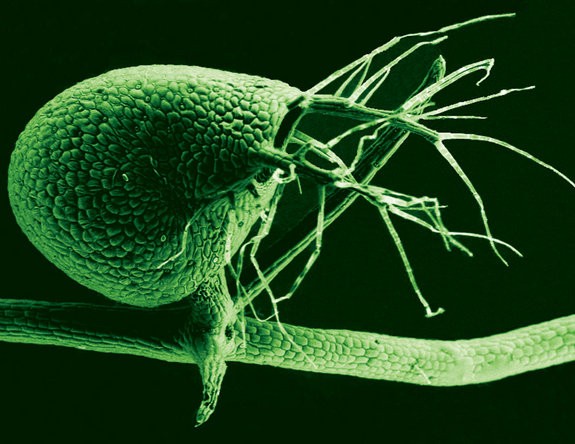Carnivorous Bladderwort has More DNA than Genes
| Marco Foronda | | Feb 24, 2015 09:48 AM EST |
(Photo : Enrique Ibarra-Laclette, Claudia Anahí Pérez-Torres and Paulina Lozano-Sotomayor) The humped bladderwort plant is a voracious carnivore.
The carnivorous bladderwort has some mind-bending genetic material. The aquatic plant has a smaller genome than many well-known plants but more genes.
Bladderwort or "Utricularia gibba" lives in an aquatic environment and has no recognizable roots. It has floating, thread-like branches along with miniature traps that use vacuum pressure to capture prey.
Like Us on Facebook
Researchers have broken down the plant's genetic makeup and found a fascinating story. With 80 million base pairs of DNA, bladderwort is six times smaller than the grape but has 28,500 genes to the grape's 26,300.
"The story is that we can see that throughout its history, the bladderwort has habitually gained and shed oodles of DNA", said study leader Victor Albert, professor of biological sciences at the University at Buffalo.
"With a shrunken genome we might expect to see what I would call a minimal DNA complement: a plant that has relatively few genes-only the ones needed to make a simple plant. But that's not what we see".
The new study suggests the plant may owe its super-compact genome to a long history of rampant DNA editing.
Basically, the carnivorous little plant is gaining and throwing away DNA at an unusually rapid pace. Albert and his colleagues believe the plant's genome has duplicated entirely at least three times. But instead of just adding all of those redundant genes to its DNA, it has kept cutting out the chaff.
The study builds on the work of Albert and other team members. It reports the bladderwort's genome consists almost entirely of useful, functional genes and their controlling elements in contrast to species like humans, whose genomes are more than 90 percent "junk DNA."
The study included partners from the University at Buffalo, the Universitat de Barcelona in Spain, the Laboratorio Nacional de Genómica para la Biodiversidad (LANGEBIO) in Mexico, and the Instituto de Ecología in Mexico.
The study was published in Molecular Biology and Evolution.
TagsCarnivorous plant, Carnivorous Bladderwort, DNA, genes, Plants, aquatic plant, aquatic environment
©2015 Chinatopix All rights reserved. Do not reproduce without permission
EDITOR'S PICKS
-

Did the Trump administration just announce plans for a trade war with ‘hostile’ China and Russia?
-

US Senate passes Taiwan travel bill slammed by China
-

As Yan Sihong’s family grieves, here are other Chinese students who went missing abroad. Some have never been found
-

Beijing blasts Western critics who ‘smear China’ with the term sharp power
-

China Envoy Seeks to Defuse Tensions With U.S. as a Trade War Brews
-

Singapore's Deputy PM Provides Bitcoin Vote of Confidence Amid China's Blanket Bans
-

China warns investors over risks in overseas virtual currency trading
-

Chinese government most trustworthy: survey
-

Kashima Antlers On Course For Back-To-Back Titles
MOST POPULAR
LATEST NEWS
Zhou Yongkang: China's Former Security Chief Sentenced to Life in Prison

China's former Chief of the Ministry of Public Security, Zhou Yongkang, has been given a life sentence after he was found guilty of abusing his office, bribery and deliberately ... Full Article
TRENDING STORY

China Pork Prices Expected to Stabilize As The Supplies Recover

Elephone P9000 Smartphone is now on Sale on Amazon India

There's a Big Chance Cliffhangers Won't Still Be Resolved When Grey's Anatomy Season 13 Returns

Supreme Court Ruled on Samsung vs Apple Dispute for Patent Infringement

Microsoft Surface Pro 5 Rumors and Release Date: What is the Latest?










